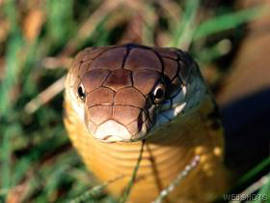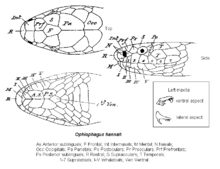This article is about the snake. For other uses, see King Cobra (disambiguation).
| King Cobra | |
|---|---|
 | |
| Conservation status | |
 Least Concern (IUCN 3.1) | |
| Scientific classification | |
| Kingdom: | Animalia |
| Phylum: | Chordata |
| Class: | Reptilia |
| Order: | Squamata |
| Suborder: | Serpentes |
| Family: | Elapidae |
| Genus: | Ophiophagus |
| Species: | O. hannah |
| Binomial name | |
| Ophiophagus hannah Cantor, 1836 | |
 | |
| Distribution of the King Cobra | |
Profile
The King Cobra is a large and powerful snake, averaging 3.6–4 m (12–13 feet) in length and typically weighing about 6 kg (13.2 lb). A particularly large specimen was kept captive at the London Zoo and grew to 5.7 m (18.8 ft) before being euthanized upon the outbreak of World War II. Despite their large size, King Cobras are fast and agile.Characteristics
The skin of this snake is either olive-green, tan, or black and it has faint, pale yellow cross bands down the length of the body. The belly is cream or pale yellow, and the scales are smooth. Juveniles are shiny black with narrow yellow bands(can be mistaken for a Banded Krait but readily identified with its expanded hood). The head of a mature snake can be quite massive and bulky in appearance, though like all snakes, they can expand their jaws to swallow large prey items. It has proteroglyph dentition, meaning it has two short, fixed fangs in the front of the mouth which channel venom into the prey like hypodermic needles. The male is larger and thicker than the female. The average lifespan of a King Cobra is about 20 years.Identification
The King Cobra is not actually a member of the cobra family; it belongs to its own genus instead of the Naja genus. It can be identified from other cobras by its size and the pattern on its neck. King cobras are larger than other cobras, and the stripe on its neck is like the symbol "^" instead of a double or single eye(s) shape that may be seen in other cobras.Habitat
The King Cobra is distributed across South and South-east Asia, but is not common. It lives in dense highland forests, preferring areas dotted with lakes and streams. King Cobra populations have dropped in some areas of its range because of the destruction of forests, but despite this the snake is not listed by the IUCN as in danger of becoming extinct. It is, however, listed as an Appendix II Animal within CITES.
Behavior
King Cobras, like other snakes, receive chemical information (“smell”) via their forked tongues, which pick up scent particles and transfer them to a special sensory receptor (Jacobson's Organ) located in the roof of its mouth. When the scent of a meal has been detected, the snake will flick its tongue to gauge the prey's direction (the twin forks of the tongue acting in stereo); it will also rely on its keen eyesight (King Cobras are able to detect moving prey almost 100 m [300 feet] away), intelligence and sensitivity to earth-borne vibration to track its prey. Following envenomation, the King Cobra will begin to swallow its struggling prey while its toxins begin the digestion of its victim. King Cobras, as with all other snakes, do not have rigidly fixed jaws. Instead, the jaw bones are connected by extremely pliable ligaments, enabling the lower jaw bones to move independently of each other. Like other snakes, the King Cobra does not chew its food, instead it swallows its prey whole. The expansion of the jaw enables the snake to swallow prey much larger than its head.King Cobras are able to hunt at all times of day, although it is rarely seen at night, leading most herpetologists to classify it as a diurnal species.
When threatened, King Cobras raise up one-third of their body, flattening the neck (which can be the girth of an adult's forearm), showing the fangs and hissing loudly. They are easily irritated by closely approaching objects or sudden movements. King cobras attack quickly and the strike distance can be as far as 7 feet, people can easily misjudge the safe distance. King Cobras can deliver more than one bite in a single attack when feeling concern. Also, they will have a strong hold when they do bite.
If a King Cobra encounters a natural predator, such as the mongoose, which has some resistance to the neurotoxins, the snake generally tries to flee. If unable to do so, it forms the distinctive cobra hood and emits a high-pitched hiss, sometimes with feigned closed-mouth strikes. These efforts usually prove to be very effective, especially since the King Cobra is more dangerous than other mongoose prey as well as being much too large for the small mammal to kill with ease.
Diet
King cobra's genus name, Ophiophagus, literally means "snake-eater", and its diet consists primarily of other snakes, including rat snakes, sizeable pythons and even other venomous snakes (including kraits, cobras and smaller members of its own species). When food is scarce, King Cobras may also feed on other small vertebrates such as lizards, birds, and rodents. In some cases, the cobra may “constrict” its prey, like birds and larger rodents using its muscular body, though this is uncommon. After a large meal the snake may live for many months without another one because of its slow metabolic rate. The King Cobra's most common meal is the Ratsnake. This leads King Cobras near human settlements.Venom
The venom of King Cobra is primarily neurotoxic but also contains cardiotoxic compounds. It is composed mostly of proteins and polypeptides. During a bite, venom is forced through the snake's half-inch (1.25 cm) fangs and into the wound, and quickly attacks the victim's central nervous system and induces severe pain, blurred vision, vertigo, drowsiness, and paralysis. Envenomation progresses to cardiovascular collapse, and the victim falls into a coma. Death soon follows due to respiratory failure. In the past, the LD50 of King Cobra’s venom was treated as 1.7 mg/kg (which is one of the least toxic elapids.) However, this is not always true. According to the recent toxinology study, the LD50 of Chinese King Cobra venom is 0.34 mg/kg This shows that actually King Cobra can be more venomous than most of the other species with its range, like chinese cobra. The King Cobra is also capable of delivering larger quantities of venom than most other venomous snakes, injecting a 380-600 mg dose in a single bite. This quantity is enough to kill 20-40 grown men or even an elephant. One bite from a King Cobra can cause the death of a healthy adult human within 15 minutes, but death usually occurs between 30–45 minutes.The mortality rate from a bite can be over 75%, or only 33%, depending upon treatment details. It is regarded as one of the deadliest snakes in the world.There are two types of antivenom made specifically to treat King Cobra envenomations. The Red Cross in Thailand manufactures one, and the Central Research Institute in India manufactures the other; however, both are made in small quantities and are not widely available. Ohanin, a protein component of the venom, causes hypolocomotion and hyperalgesia in mammals. Other components have cardiotoxic,cytotoxic and neurotoxic effects.
Reproduction
The female King Cobra is a very dedicated parent. Before she is ready to lay her eggs, she uses the coils of her long body to gather a big mound of leaf litter. She deposits 20–40 eggs into the mound, which acts as an incubator. The female stays with her eggs and guards the mound tenaciously, rearing up into a threat display if any large animal gets too close.Inside the mound that the female has built the eggs are incubated at a steady 28 °C (82 °F). When the eggs start to hatch, instinct causes her to leave the nest and find prey to eat so that she does not eat her young. The baby King Cobras can have a length of 55 cm (22 in), and have already developed potent venom which is as deadly as that of an adult.


























No comments:
Post a Comment